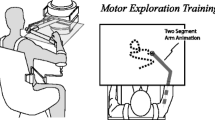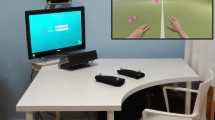Abstract
Quantification of motor performance is an important component of the rehabilitation of humans with sensory-motor disability. We developed a method for assessing arm movement performance of trainees (patients) termed “probability tube” (PT). PT captures the stochastic characteristics of a desired movement when repeated by an expert (therapist). The PT is being generated automatically from data recorded during point-to-point movement executed not more than 15 repetitions by the clinician and/or other non-expert programmer in just a few minutes. We introduce the index, termed probability tube score (PTS), as a single “goodness-of-fit” value allowing quantified analysis of the recovery and effects of the therapy. This index in fact scores the difference between the movement (velocity profile) executed by the trainee and the velocity profile of the desired movement (executed by the expert). We document the goodness of the automatic method with results from studies which included healthy subjects and show the use of the PTS in healthy and post-stroke hemiplegic subjects.







Similar content being viewed by others
References
Abend W, Bizzi E, Morasso P (1982) Human arm trajectory formation. Brain J Neurol 105:331
Barsi GI, Popovic DB, Tarkka IM, Sinkjar T, Grey MJ (2008) Cortical excitability changes following grasping exercise augmented with electrical stimulation. Exp Brain Res 191:57–66
Bayona NA, Bitensky J, Salter K, Teasell R (2005) The role of task-specific training in rehabilitation therapies. Top Stroke Rehabil 12:58
Bosecker C, Dipietro L, Volpe B, Krebs HI (2010) Kinematic robot-based evaluation scales and clinical counterparts to measure upper limb motor performance in patients with chronic stroke. Neurorehabil Neural Repair 24:62–69
Colombo R, Pisano F, Micera S, Mazzone A, Delconte C, Carrozza MC, Dario P, Minuco G (2005) Robotic techniques for upper limb evaluation and rehabilitation of stroke patients. IEEE Trans Neural Syst Rehabil Eng 13:311–324
Colombo R, Sterpi I, Mazzone A, Delconte C, Minuco G, Pisano F (2010) Measuring changes of movement dynamics during robot-aided neurorehabilitation of stroke patients. IEEE Trans Neural Syst Rehabil Eng 18:75–85
Daly JJ, Hogan N, Perepezko EM, Krebs HI, Rogers JM, Goyal KS, Dohring ME, Fredrickson E, Nethery J, Ruff RL (2005) Response to upper-limb robotics and functional neuromuscular stimulation following stroke. J Rehabil Res Dev 42:723–736
Dipietro L, Krebs HI, Fasoli SE, Volpe BT, Stein J, Bever C, Hogan N (2007) Changing motor synergies in chronic stroke. J Neurophysiol 98:757–768
Dipietro L, Krebs HI, Fasoli SE, Volpe BT, Hogan N (2009) Submovement changes characterize generalization of motor recovery after stroke. Cortex 45:318–324
Dovat L, Lambercy O, Salman B, Johnson V, Milner T, Gassert R, Burdet E, Leong TC (2010) A technique to train finger coordination and independence after stroke. Disabil Rehabil Assist Technol 5:279–287
Flash T, Hogan N (1985) The coordination of arm movements: an experimentally confirmed mathematical model. J Neurosci 5:1688–1703
Fradet L, Lee G, Dounskaia N (2008) Origins of submovements during pointing movements. Acta Psychol 129:91–100
Gottlieb GL, Song Q, Hong DA, Almeida GL, Corcos D (1996) Coordinating movement at two joints: a principle of linear covariance. J Neurophysiol 75:1760–1764
Hingtgen B, McGuire JR, Wang M, Harris GF (2006) An upper extremity kinematic model for evaluation of hemiparetic stroke. J Biomech 39:681–688
Hogan N (1984) An organizing principle for a class of voluntary movements. J Neurosci 4:2745–2754
Hollerbach JM, Flash T (1982) Dynamic interactions between limb segments during planar arm movement. Biol Cybern 44:67–77
Kelso JS, Southard DL, Goodman D (1979) On the nature of human interlimb coordination. Science 203:1029–1031
Knaut LA, Subramanian SK, McFadyen BJ, Bourbonnais D, Levin MF (2009) Kinematics of pointing movements made in a virtual versus a physical 3-dimensional environment in healthy and stroke subjects. Arch Phys Med Rehabil 90:793–802
Kollen B, Kwakkel G, Lindeman E (2006) Functional recovery after stroke: a review of current developments in stroke rehabilitation research. Reviews on recent clinical trials 1:75–80
Kostic MD, Popovic DB (2011) Action representation of point to point movements: classification with probability tube, 22 Nov 2011. IEEE 19th telecommunications forum TELFOR, Belgrade, Serbia, pp 43–46
Kostic MD, Popovic MB, Popovic DB (2012) Control of robot assistant for rehabilitation of upper extremities. Annual international conference of the IEEE Engineering in Medicine and Biology Society (EMBC), pp 3918–3921
Krabben T, Molier B, Houwink A, Rietman J, Buurke J, Prange G (2011) Circle drawing as evaluative movement task in stroke rehabilitation: an explorative study. J NeuroEng Rehabil 8:15
Kwakkel G (2009) Intensity of practice after stroke: more is better. Schweizer Archiv für Neurologie und Psychiatrie 160(7):295–298
Kwakkel G, Kollen B, Lindeman E (2004) Understanding the pattern of functional recovery after stroke: facts and theories. Restorative neurology and neuroscience 22:281–300
Lang CEWJ, Dromerick AWED (2006) Measurement of upper-extremity function early after stroke: properties of the action research arm test. Arch Phys Med Rehabil 87:1605–1610
Langhorne P, Bernhardt J, Kwakkel G (2011) Stroke rehabilitation. The Lancet 377:1693–1702
Lum PS, Burgar CG, Kenney DE, Van der Loos HFM (1999) Quantification of force abnormalities during passive and active-assisted upper-limb reaching movements in post-stroke hemiparesis. IEEE Trans Biomed Eng 46:652–662
Lum PS, Burgar CG, Shor PC (2004) Evidence for improved muscle activation patterns after retraining of reaching movements with the MIME robotic system in subjects with post-stroke hemiparesis. IEEE Trans Neural Syst Rehabil Eng 12:186–194
Morasso P (1981) Spatial control of arm movements. Exp Brain Res 42:223–227
Oldfield RC (1971) The assessment and analysis of handedness: the Edinburgh inventory. Neuropsychologia 9:97–113
Popovic MB, Popovic DB, Sinkjar T, Stefanovic A, Schwirtlich L (2003) Clinical evaluation of functional electrical therapy in acute hemiplegic subjects. J Rehabil Res Dev 40:443–454
Rensink M, Schuurmans M, Lindeman E, Hafsteinsdottir T (2009) Task-oriented training in rehabilitation after stroke: systematic review. J Adv Nurs 65:737–754
Schmidt RA, Lee TD (2005) Motor control and learning: a behavioral emphasis. Human Kinetics Publishers, Champaign
Van der Lee JH, De Groot V, Beckerman H, Wagenaar RC, Lankhorst GJ, Bouter LM (2001) The intra-and interrater reliability of the action research arm test: a practical test of upper extremity function in patients with stroke. Arch Phys Med Rehabil 82:14–19
Vergaro E, Casadio M, Squeri V, Giannoni P, Morasso P, Sanguineti V (2010) Self-adaptive robot training of stroke survivors for continuous tracking movements. J NeuroEng Rehabil 7:13
Winstein CJ, Wolf SL (2009) Task-oriented training to promote upper extremity recovery Stroke Recovery and Rehabilitation. Demos Medical Publishing, New York, pp 267–290
Zheng H, Black ND, Harris ND (2005) Position-sensing technologies for movement analysis in stroke rehabilitation. Med Biol Eng Comput 43:413–420
Zollo L, Rossini L, Bravi M, Magrone G, Sterzi S, Guglielmelli E (2011) Quantitative evaluation of upper-limb motor control in robot-aided rehabilitation. Med Biol Eng Comput 49:1131–1144
Acknowledgments
We would like to thank the healthy volunteers who participated in the measurements and the patients who participated in the clinical tests. This work was partially supported by the Ministry of Education, Science and Technological Development, Republic of Serbia, Belgrade, Project No. 175016, and by the Swiss National Foundation, Berne (Project InRES, IZ73Z0_128134/1). We thank Prof. Ljubica Konstantinović, M.D. and Sindi Mitrović, M.D. from the “Dr. Miroslav Zotović” Rehabilitation Clinic for their assistance in recruiting the patients for the clinical study.
Conflict of interest
None.
Author information
Authors and Affiliations
Corresponding author
Electronic supplementary material
Below is the link to the electronic supplementary material.
Glossary
- Movement phase
-
Current position (short portion of the trajectory) during the movement expressed with respect the length of the trajectory.
- Probabilistic movement primitive
-
The distribution of velocity estimated from the data recorded during repetitive movements along the target trajectory at a specific movement phase.
- Probability Tube (PT)
-
The movement representation comprising a sequence of probabilistic movement primitives along the trajectory.
- Probability Tube Score (PTS)
-
A numerical value between 0 and 1 used as a measure of movement performance. The PTS = 1 denotes perfect match, while PTS = 0 signifies a major discrepancy between the tested and target movement representation.
Rights and permissions
About this article
Cite this article
Kostić, M., Popović, M.B. & Popović, D.B. A method for assessing the arm movement performance: probability tube. Med Biol Eng Comput 51, 1315–1323 (2013). https://doi.org/10.1007/s11517-013-1104-z
Received:
Accepted:
Published:
Issue Date:
DOI: https://doi.org/10.1007/s11517-013-1104-z




